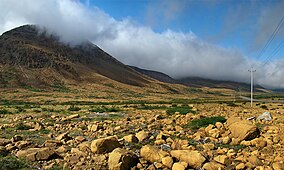Gros Morne National Park
| Gros Morne National Park | |
|---|---|
|
IUCN category II (national park)
|
|

The Tablelands in Gros Morne National Park
|
|
| Location of Gros Morne National Park | |
| Location | Rocky Harbour, Newfoundland and Labrador, Canada |
| Coordinates | 49°41′22″N 57°44′17″W / 49.68944°N 57.73806°WCoordinates: 49°41′22″N 57°44′17″W / 49.68944°N 57.73806°W |
| Area | 1,805 km2 (697 sq mi) |
| Established | 1973 |
| Governing body | Parks Canada |
| Type | Natural |
| Criteria | vii, viii |
| Designated | 1987 (11th session) |
| Reference no. | 419 |
| State Party |
|
| Region | Europe and North America |
Gros Morne National Park is a world heritage site located on the west coast of Newfoundland. At 1,805 km2 (697 sq mi), it is the second largest national park in Atlantic Canada; it is surpassed by Torngat Mountains National Park, which is 9,700 km2 (3,700 sq mi).
The park takes its name from Newfoundland's second-highest mountain peak (at 806 m or 2,644 ft) located within the park. Its French meaning is "large mountain standing alone," or more literally "great sombre." Gros Morne is a member of the Long Range Mountains, an outlying range of the Appalachian Mountains, stretching the length of the island's west coast. It is the eroded remnants of a mountain range formed 1.2 billion years ago. "The park provides a rare example of the process of continental drift, where deep ocean crust and the rocks of the earth's mantle lie exposed."
The Gros Morne National Park Reserve was established in 1973, and was made a national park on October 1, 2005.
The park was the subject of a short film in 2011's National Parks Project, directed by Sturla Gunnarsson and scored by Melissa Auf der Maur, Sam Shalabi and Jamie Fleming.
The park's rock formations, made famous by Robert Stevens and Harold Williams, include oceanic crust and mantle rock exposed by the obduction process of plate tectonics, as well as sedimentary rock formed during the Ordovician, Precambrian granite and Palaeozoic igneous rocks.
...
Wikipedia

